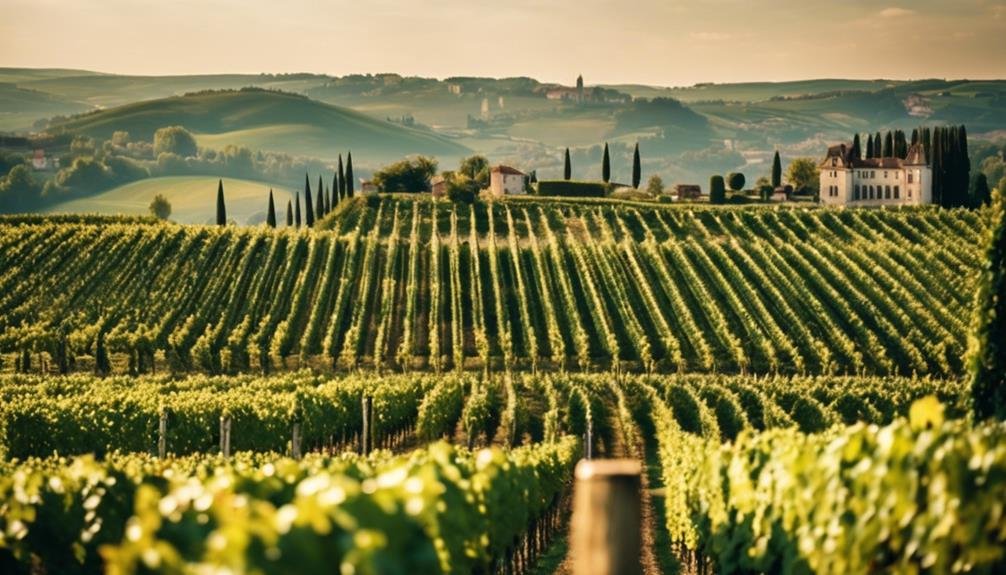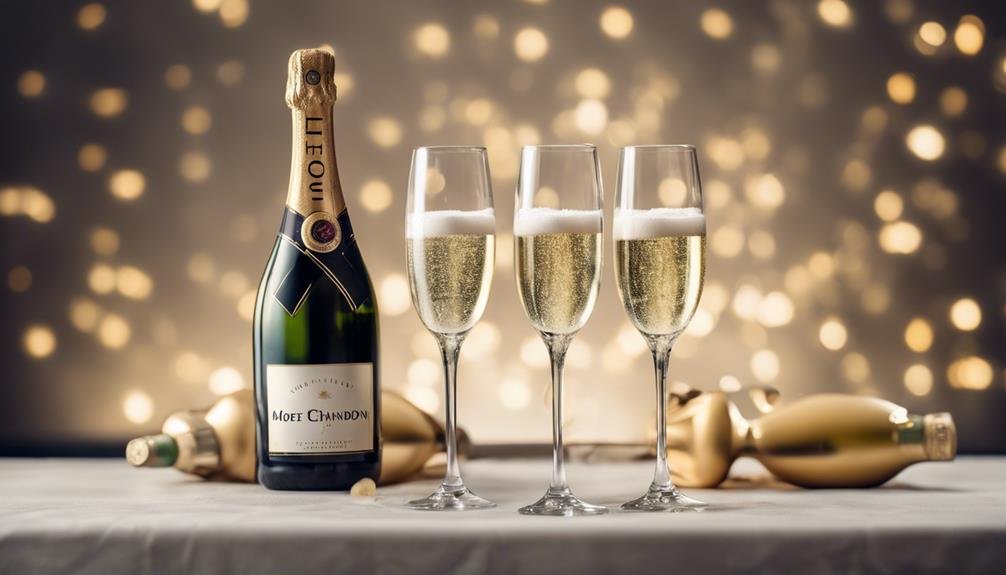Champagne, from France, uses Chardonnay, Pinot Noir, and Pinot Meunier grapes, made through the traditional method. It showcases fine bubbles and flavors like almond, orange-zest, and white cherry. In contrast, Prosecco comes from Italy's Veneto region, with mainly Glera grapes, using the Tank Method. It offers vibrant fruit and flower aromas, frothy bubbles, and tropical fruit, banana cream, hazelnut, vanilla, and honeycomb notes. Champagne thrives in a cool climate, while Prosecco benefits from Valdobbiadene's unique microclimate. Notable brands like Moët & Chandon represent Champagne, whereas Nino Franco and Bisol shine in the Prosecco world. More insights await about these exquisite sparkling wines.
Origins and Production Methods
In the world of sparkling wines, the distinction between Champagne and Prosecco lies not only in their origins but also in their distinct production methods.
Champagne, originating from the Champagne region in France, is primarily made with Chardonnay, Pinot Noir, and Pinot Meunier grapes. It is produced using the traditional method, resulting in a complex and elegant flavor profile.
On the other hand, Prosecco hails from Veneto, Italy near Treviso and is mainly made with Prosecco (Glera) grapes using the Tank Method. This production process gives Prosecco its boisterous fruit and flower aromas, making it a lively and vibrant sparkling wine option.
The differences in Champagne grapes and the Prosecco process contribute to the unique characteristics of these two popular sparkling wines.
Tasting Notes and Aromas
Highlighted by their distinct aromas and flavors, Champagne and Prosecco offer unique tasting notes that cater to different palates and occasions.
Champagne presents fine, persistent bubbles with almond-like flavors and hints of orange-zest and white cherry, thanks to its traditional production method. The aging process adds aromas of toast, brioche, or biscuit, with some Champagnes showcasing strange cheese rind notes.
On the other hand, Prosecco delights with boisterous fruit and flower aromas, accompanied by lighter, frothy bubbles that enhance the experience. Aromas of tropical fruits, banana cream, hazelnut, vanilla, and honeycomb characterize Prosecco, making it a versatile option for pairings with cured meats, fruit-driven appetizers, and Asian cuisine, including the classic Pad Thai.
Regional Differences and Climate

Distinguished by their geographical origins and climatic conditions, Champagne and Prosecco exhibit unique regional differences that influence their flavor profiles and characteristics.
Champagne, hailing from a northerly climate, experiences cooler temperatures that lead to grapes with higher acidity levels. This climate variation results in a crisp and vibrant taste in Champagne, with distinct almond-like flavors and citrusy notes.
On the other hand, Prosecco, particularly from the Valdobbiadene region in Italy, benefits from a unique microclimate that contributes to its boisterous fruit and floral aromas. The warmer climate in this region allows Prosecco grapes to ripen differently, resulting in a lighter and fruitier profile with hints of tropical fruits and honeycomb.
These terroir influences play a significant role in shaping the flavor profiles of Champagne and Prosecco, making them distinct sparkling wines.
Price Disparities and Perceptions
The contrasting price points between Champagne and Prosecco reflect the differing perceptions of luxury and value associated with these two sparkling wines. Champagne is often perceived as a luxury item, hence commanding higher prices, while Prosecco is viewed as a value sparkler, making it more affordable and appealing to a wider audience.
Market demand and positioning play a significant role in shaping these price differences. Despite the affordability appeal of Prosecco, exceptional wines can be found, particularly from Conegliano Valdobbiadene. Champagne's higher costs are justified by its time-intensive production methods, contributing to its luxurious image and higher price point.
Luxury perception and affordability appeal are key factors influencing the pricing and consumer preferences between Champagne and Prosecco.
Notable Producers and Recommendations

Among the esteemed producers in the sparkling wine industry, certain names consistently stand out for their quality and innovation. When it comes to Champagne, renowned houses like Moët & Chandon, Veuve Clicquot, and Dom Pérignon are top recommendations known for their exceptional craftsmanship and heritage.
For Prosecco, hidden gems such as Nino Franco and Bisol offer delightful options that showcase the diversity and character of the region. Additionally, celebrity collaborations like Jay-Z's partnership with Armand de Brignac bring a unique flair to the sparkling wine market.
Keep an eye out for rising stars like Ferrari Trento, gaining recognition for their outstanding sparkling wines. These producers offer a range of choices that cater to various preferences and occasions.
Frequently Asked Questions
What Are the Environmental Impacts of Champagne and Prosecco Production?
When evaluating the environmental impacts of Champagne and Prosecco production, one must consider their carbon footprints, vineyard management practices influencing water consumption, and the fermentation process. These factors play a crucial role in the sustainability of winemaking operations.
How Do the Grape Varieties Used in Champagne and Prosecco Affect Taste?
The choice of grape varieties in Champagne and Prosecco greatly impacts taste. Champagne's Chardonnay, Pinot Noir, and Pinot Meunier create complex, toasty flavors. Prosecco's Glera grapes offer fruity and floral notes. Such differences contribute to the distinct profiles of these sparkling wines.
Are There Any Sustainable Practices Employed by Champagne and Prosecco Producers?
Both Champagne and Prosecco producers are increasingly adopting sustainable practices to reduce their carbon footprint. From organic farming methods to eco-friendly packaging, these initiatives aim to preserve the environment while ensuring the quality of their sparkling wines.
What Historical Events Have Influenced the Development of Champagne and Prosecco?
The historical development of Champagne and Prosecco is intricately tied to significant events like the French Revolution and Italian Renaissance. These periods influenced viticulture practices, grape cultivation, and winemaking techniques, shaping these renowned sparkling wines' unique characters.
How Do Champagne and Prosecco Pair With Non-Traditional Foods Like Spicy Dishes or Desserts?
Champagne's high acidity and complex flavors complement spicy dishes, while Prosecco's fruity notes harmonize well with sweet treats. Both sparkling wines offer versatility in pairing with non-traditional foods, enhancing the dining experience with contrasting or complementary flavors.
Conclusion
To wrap up, Champagne and Prosecco offer distinct characteristics and flavors that cater to diverse preferences.
An interesting statistic to note is that Champagne sales reached over 307 million bottles in 2019, highlighting its enduring popularity and global demand.
Whether you prefer the elegance of Champagne or the accessibility of Prosecco, both sparkling wines have their unique appeal and charm that continue to captivate wine enthusiasts worldwide.
Cheers to exploring the world of sparkling wines!